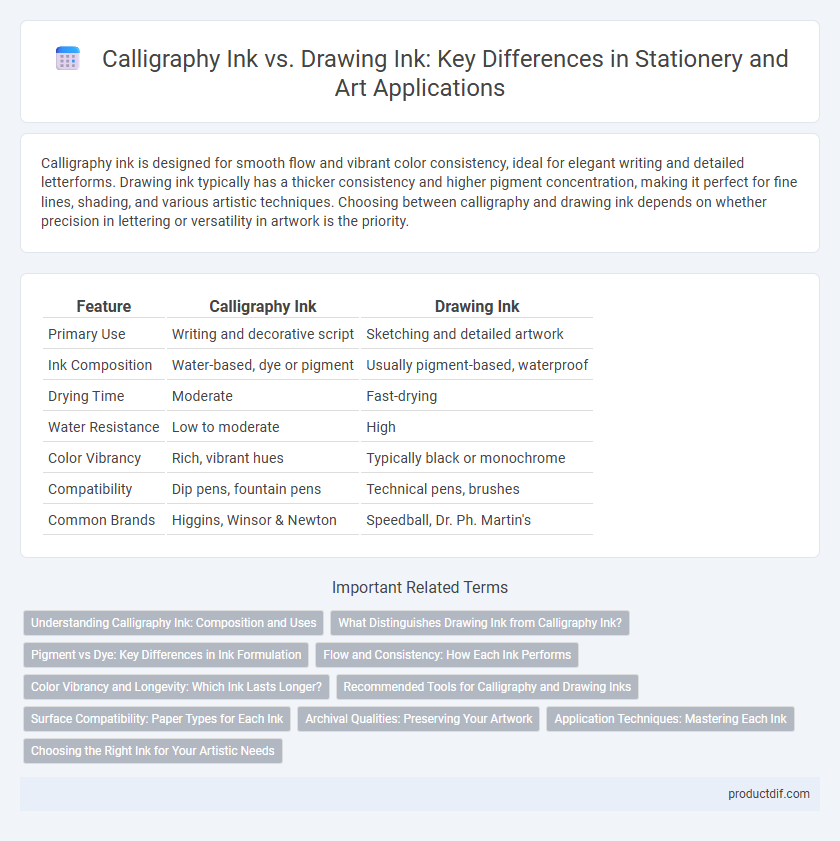Calligraphy ink is designed for smooth flow and vibrant color consistency, ideal for elegant writing and detailed letterforms. Drawing ink typically has a thicker consistency and higher pigment concentration, making it perfect for fine lines, shading, and various artistic techniques. Choosing between calligraphy and drawing ink depends on whether precision in lettering or versatility in artwork is the priority.
Table of Comparison
| Feature | Calligraphy Ink | Drawing Ink |
|---|---|---|
| Primary Use | Writing and decorative script | Sketching and detailed artwork |
| Ink Composition | Water-based, dye or pigment | Usually pigment-based, waterproof |
| Drying Time | Moderate | Fast-drying |
| Water Resistance | Low to moderate | High |
| Color Vibrancy | Rich, vibrant hues | Typically black or monochrome |
| Compatibility | Dip pens, fountain pens | Technical pens, brushes |
| Common Brands | Higgins, Winsor & Newton | Speedball, Dr. Ph. Martin's |
Understanding Calligraphy Ink: Composition and Uses
Calligraphy ink is specially formulated with pigments or dyes that provide smooth flow and rich, vibrant colors suitable for various nib sizes and brush types. Its composition typically includes water, gum arabic for flexibility, and additives that enhance permanence and prevent feathering on paper. Designed primarily for decorative writing and artistic lettering, calligraphy ink offers superior control and intensity compared to standard drawing inks.
What Distinguishes Drawing Ink from Calligraphy Ink?
Drawing ink differs from calligraphy ink primarily in composition and application; it often contains waterproof pigments that provide durability and resistance to smudging, making it ideal for technical drawings and illustrations. Calligraphy ink is typically fluid and dye-based, designed to flow smoothly from dip pens and brushes, allowing for elegant, expressive strokes with varying line thickness. The differing viscosity and permanence in these inks address distinct artistic needs, emphasizing precision for drawing ink and aesthetic fluidity for calligraphy ink.
Pigment vs Dye: Key Differences in Ink Formulation
Calligraphy ink typically uses dye-based formulations that provide vibrant, smooth flow ideal for elegant script and quick drying on paper. Drawing ink often relies on pigment-based formulations, offering superior opacity, lightfastness, and water resistance suited for detailed artwork and archival quality. The fundamental difference lies in the molecular structure, where dyes dissolve completely in the binder, while pigments are composed of fine solid particles suspended in the medium, affecting permanence and texture.
Flow and Consistency: How Each Ink Performs
Calligraphy ink typically features a smooth, fluid consistency designed for controlled, elegant strokes, ensuring steady flow with minimal blotting on paper. Drawing ink often has a thicker, more viscous texture optimized for precision and layering, allowing detailed line work without bleeding. The distinct flow properties of each ink cater specifically to their respective applications, enhancing artistic control and final presentation.
Color Vibrancy and Longevity: Which Ink Lasts Longer?
Calligraphy ink typically features richer color vibrancy due to its pigment density, offering brighter and more intense hues ideal for decorative lettering. Drawing ink, designed for fine lines and detailed illustrations, often prioritizes longevity and water resistance, resulting in longer-lasting permanence on various surfaces. While calligraphy ink shines in color brilliance, drawing ink outperforms in durability and archival stability for long-term preservation.
Recommended Tools for Calligraphy and Drawing Inks
Calligraphy ink typically requires tools such as dip pens, fountain pens, and brush pens designed for smooth, consistent flow and delicate line work, while drawing ink is best paired with technical pens, nib pens, and brushes that allow for varied line thickness and detailed shading. High-quality calligraphy inks like sumi or iron gall ink work well on smooth, absorbent paper, whereas waterproof drawing inks are ideal for mixed media surfaces and layering techniques. Choosing the right nib size and brush type enhances control and precision, ensuring optimal results for each ink's specific characteristics.
Surface Compatibility: Paper Types for Each Ink
Calligraphy ink is specially formulated for smooth, absorbent papers such as rice paper, vellum, and high-quality parchment, ensuring crisp, fluid lines without bleeding. Drawing ink performs best on a wider range of surfaces including illustration board, Bristol paper, and mixed media sheets, providing bold, consistent marks and quick drying times. Selecting the right paper enhances the ink's performance, preserving the artwork's sharpness and longevity.
Archival Qualities: Preserving Your Artwork
Calligraphy ink typically features high archival quality with fade-resistant pigments designed to preserve the crispness and vibrancy of handwritten art over decades. Drawing ink, while also available in archival formulations, often emphasizes waterproof and quick-drying properties suitable for detailed sketches but may vary in longevity depending on pigment type. Choosing inks with verified lightfastness and acid-free composition ensures long-term preservation and protection of your artwork from yellowing and degradation.
Application Techniques: Mastering Each Ink
Calligraphy ink, designed for smooth flow and rich pigmentation, excels in brush and dip pen techniques, allowing artists to create elegant strokes with varied thickness and sharp contrasts. Drawing ink, formulated for precision and permanence, is ideal for technical pens and fine liners, providing consistent lines essential for detailed artwork and illustrations. Mastery involves selecting the right ink based on surface absorption and drying time, ensuring optimal control and desired visual effects in both calligraphy and drawing applications.
Choosing the Right Ink for Your Artistic Needs
Calligraphy ink is designed for smooth, flowing strokes and high pigmentation, ideal for lettering and elegant script, while drawing ink offers varied consistencies and waterproof properties suited for detailed illustrations and mixed media. Selecting the right ink depends on the intended use: calligraphy ink excels in precision and vibrancy for penmanship, whereas drawing ink provides durability and versatility for sketches and technical drawings. Understanding ink properties such as drying time, water resistance, and color intensity ensures optimal results for your artistic projects.
Calligraphy Ink vs Drawing Ink Infographic

 productdif.com
productdif.com